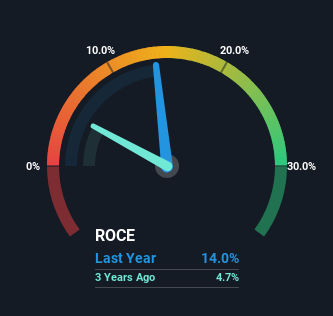Be Wary Of Aritzia (TSE:ATZ) And Its Returns On Capital
If we want to find a stock that could multiply over the long term, what are the underlying trends we should look for? Ideally, a business will show two trends; firstly a growing return on capital employed (ROCE) and secondly, an increasing amount of capital employed. Put simply, these types of businesses are compounding machines, meaning they are continually reinvesting their earnings at ever-higher rates of return. Although, when we looked at Aritzia (TSE:ATZ), it didn't seem to tick all of these boxes.
Return On Capital Employed (ROCE): What Is It?
If you haven't worked with ROCE before, it measures the 'return' (pre-tax profit) a company generates from capital employed in its business. Analysts use this formula to calculate it for Aritzia:
Return on Capital Employed = Earnings Before Interest and Tax (EBIT) ÷ (Total Assets - Current Liabilities)
0.14 = CA$198m ÷ (CA$1.9b - CA$527m) (Based on the trailing twelve months to August 2023).
So, Aritzia has an ROCE of 14%. In absolute terms, that's a pretty normal return, and it's somewhat close to the Specialty Retail industry average of 12%.
See our latest analysis for Aritzia

In the above chart we have measured Aritzia's prior ROCE against its prior performance, but the future is arguably more important. If you'd like, you can check out the forecasts from the analysts covering Aritzia here for free.
What Does the ROCE Trend For Aritzia Tell Us?
In terms of Aritzia's historical ROCE movements, the trend isn't fantastic. Around five years ago the returns on capital were 22%, but since then they've fallen to 14%. However, given capital employed and revenue have both increased it appears that the business is currently pursuing growth, at the consequence of short term returns. And if the increased capital generates additional returns, the business, and thus shareholders, will benefit in the long run.
On a side note, Aritzia's current liabilities have increased over the last five years to 27% of total assets, effectively distorting the ROCE to some degree. If current liabilities hadn't increased as much as they did, the ROCE could actually be even lower. While the ratio isn't currently too high, it's worth keeping an eye on this because if it gets particularly high, the business could then face some new elements of risk.
The Bottom Line On Aritzia's ROCE
Even though returns on capital have fallen in the short term, we find it promising that revenue and capital employed have both increased for Aritzia. Furthermore the stock has climbed 58% over the last five years, it would appear that investors are upbeat about the future. So should these growth trends continue, we'd be optimistic on the stock going forward.
If you'd like to know more about Aritzia, we've spotted 2 warning signs, and 1 of them doesn't sit too well with us.
While Aritzia may not currently earn the highest returns, we've compiled a list of companies that currently earn more than 25% return on equity. Check out this free list here.
Have feedback on this article? Concerned about the content? Get in touch with us directly. Alternatively, email editorial-team (at) simplywallst.com.
This article by Simply Wall St is general in nature. We provide commentary based on historical data and analyst forecasts only using an unbiased methodology and our articles are not intended to be financial advice. It does not constitute a recommendation to buy or sell any stock, and does not take account of your objectives, or your financial situation. We aim to bring you long-term focused analysis driven by fundamental data. Note that our analysis may not factor in the latest price-sensitive company announcements or qualitative material. Simply Wall St has no position in any stocks mentioned.
